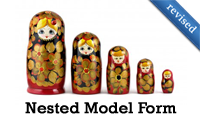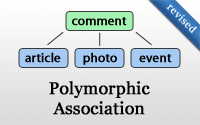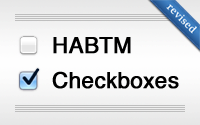Categories
- Active Record
- Active Resource
- Active Support
- Administration
- Ajax
- APIs
- Authentication
- Authorization
- Background Jobs
- Caching
- Code Walkthrough
- Controllers
- Debugging
- Deployment
- eCommerce
- Forms
- Mailing
- Models
- Performance
- Plugins
- Production
- Rack
- Rails 2.0
- Rails 2.1
- Rails 2.2
- Rails 2.3
- Rails 3.0
- Rails 3.1
- Rails 3.2
- Rails 4.0
- Refactoring
- Routing
- Search
- Security
- Testing
- Tools
- Views
Model Caching (revised)
Caching at a low level is a great option when the view is too dynamic to cache and you need something flexible that can work anywhere in the application. Here I show a variety of ways to use Rails.cache with Active Record.
(12 minutes)
Eager Loading (revised)
One way to improve performance is to reduce the number of database queries through eager loading. Here I demonstrate this and compare the difference between the "includes" and "joins" methods.
(7 minutes)
Nested Model Form (revised)
Handling multiple models in a single form is easy with accepts_nested_attributes_for. Here you will also learn how to add and remove nested records through JavaScript.
(11 minutes)
Tree-Based Navigation (revised)
If your Rails app is content-heavy, consider organizing it in a tree menu structure. Here I show how to add top-level tabs, nested links in a side bar, and breadcrumbs to go up the hierarchy.
(10 minutes)
Model Name in URL (revised)
A model's ID in the URL is not very helpful to the user. Consider adding the name which can also improve SEO. Learn how to override to_param, add a slug attribute, and make a catch all route for deep nesting.
(9 minutes)
Optimistic Locking (revised)
There is a chance one user will unintentionally override someone else's changes if they update a record near the same time. One solution is to use optimistic locking. The updated_at column can also be used for this as shown.
(8 minutes)
Site-Wide Announcements (revised)
Here I show how to add an announcement message at the top of every page in the application and allow the user to permanently hide it. This is all done test-first and even includes testing the JavaScript behavior.
(11 minutes)
Polymorphic Association (revised)
A polymorphic association allows a model to belong_to different types of other models. Here I show how to make a single comment model belong to articles, photos, and events.
(11 minutes)
Virtual Attributes (revised)
Virtual attributes are a clean way to add form fields that do not map directly to the database. Here I show how to handle validations, associations, and more.
(11 minutes)
HABTM Checkboxes (revised)
A many-to-many association can be edited through check boxes in a form. Here I show how to do this with a has_many through association complete with clickable labels.
(6 minutes)










